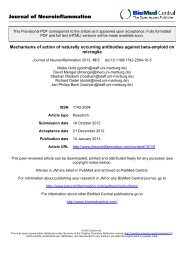View PDF - Journal of Neuroinflammation
View PDF - Journal of Neuroinflammation
View PDF - Journal of Neuroinflammation
Create successful ePaper yourself
Turn your PDF publications into a flip-book with our unique Google optimized e-Paper software.
Krstic et al. <strong>Journal</strong> <strong>of</strong> <strong>Neuroinflammation</strong> 2012, 9:151 Page 6 <strong>of</strong> 23<br />
http://www.jneuroinflammation.com/content/9/1/151<br />
sodium citrate-2-hydrate) and microwaving at 84°C followed<br />
by treatment with pepsin (involving the anti-N-APP<br />
antibody, 1:500, MAB348, clone 22C11; Millipore) as<br />
described. Before the primary antibody incubation, sections<br />
were treated for 1 hour with blocking solution (PBS<br />
(pH 7.4) containing 5% normal horse serum, 5% normal<br />
goat serum and 4% BSA). Primary antibodies were diluted<br />
in PBS (pH 7.4, with 2.5% normal horse serum, 2.5% normal<br />
goat serum and 2% BSA added), and sections were<br />
then incubated with the primary antibody overnight in a<br />
wet histochamber at 4°C under constant agitation. Sections<br />
were washed three times for 5 minutes each in PBS<br />
(pH 7.4). Secondary antibodies coupled to either Alexa<br />
Fluor 488 or Cy3 (diluted 1:1000 and 1:500, respectively,<br />
in the same buffer as for primary antibodies; Molecular<br />
Probes and Invitrogen, respectively) were added to the<br />
sections and incubated for 45 minutes. To reduce aut<strong>of</strong>luorescence<br />
<strong>of</strong> intracellular lip<strong>of</strong>uscin in aged cells, we<br />
adapted the protocol described previously [29]. Sections<br />
were treated with 0.1% Sudan Black (Carl Roth GmbH,<br />
Karlsruhe, Germany) in 70% methanol for 2 minutes in a<br />
wet histochamber and briefly washed with PBS before<br />
coverslipping. Sections were mounted with aqueous<br />
mounting medium containing DAPI (Dako) to visualize<br />
cell nuclei. Laser scanning confocal microscopy and digital<br />
imaging was performed as described above for the murine<br />
immun<strong>of</strong>luorescence staining.<br />
Protein extracts and immunoblotting<br />
Mice (Table 1) were decapitated, then the hippocampi<br />
and cortices were immediately dissected and sonicated<br />
on ice in 5 volumes <strong>of</strong> RIPA buffer (20 mmol/l Tris,<br />
150 mmol/l saline, 1% Triton X-100, 1% sodium deoxycholate,<br />
0.1% SDS) containing protease (Mini Complete<br />
Tablets TM ; Roche, Diagnostics, Basel, Switzerland) and<br />
phosphatase inhibitors (Sigma-Aldrich), and separated<br />
by centrifugation at 40,000 g at 4°C for 20 minutes. The<br />
pellet/membrane fraction was extracted in 20 μl <strong>of</strong> formic<br />
acid and resuspended in 100 μl EBS buffer (50 mmol/<br />
l Tris-Cl, pH 8.0, 120 mmol/l saline, 0.5% v/v Nonidet P-<br />
40, 5 μg/ml leupeptin, 10 μg/ml aprotinin, 50 μg/ml<br />
PMSF, 0.2 mmol/l sodium orthovanadate, 100 mmol/l sodium<br />
fluoride). Total protein concentrations <strong>of</strong> the pellet<br />
and supernatant were measured with a spectrophotometer<br />
(NanoDrop; Thermo Fisher Scientific Inc. Rockford, IL,<br />
USA) or Bradford assay (BioRad laboratories Inc,<br />
Hercules, CA, USA), respectively. Protein samples (20 μg)<br />
were separated by SDS-PAGE using 10 to 20% Tris-<br />
Tricine gels (Invitrogen, Carlsbad, CA, USA), blotted onto<br />
0.1 μm nitrocellulose (Protran; Sigma-Aldrich) (see Table 3<br />
for details). After blotting, the nitrocellulose membranes<br />
were dried at room temperature for 20 minutes [30].<br />
Membranes were blocked (Table 3) and incubated overnight<br />
at 4°C with the primary antibodies (Table 2). Before<br />
and after incubation with the secondary antibodies (horseradish<br />
peroxidase-conjugated antibodies; Jackson ImmunoResearch<br />
Laboratories), membranes were washed for 1<br />
hour in total (6 × 10 minutes) in Tris-buffered saline with<br />
Triton X-100. The signal was visualized by the enhanced<br />
chemiluminescence reaction (Amersham Biosciences Europe,<br />
Freiburg, Germany) in accordance with the manufacturer’s<br />
instructions. Quantitative analyses <strong>of</strong> the<br />
immunoreactive bands were performed on digitalized<br />
films using ImageJ s<strong>of</strong>tware (NIH). Sum pixel brightness<br />
values (the integrated density), corrected for non-specific<br />
background and equal loading using β-Actin as a control,<br />
were averaged per animal and included in the statistical<br />
analysis.<br />
ELISA<br />
ELISA microtiter plates (catalog number EZBRAIN40/<br />
42; Millipore) were used for the quantitative analysis <strong>of</strong><br />
Aβ 1–40 and Aβ 1–40/42. In addition, mouse-specific Aβ<br />
and IL-1β ELISA microtiter plates (catalog numbers<br />
KMB3481 and KMC0011, respectively; Invitrogen,<br />
Camarillo, CA, USA) and a fluorokine multi analyte<br />
pr<strong>of</strong>iling kit for the detection <strong>of</strong> IL-1α, IL-6, and<br />
tumor necrosis factor α (TNFα; catalog number<br />
LUM410; R & D Systems, Minneapolis, MN, USA) were<br />
employed to confirm the murine origin <strong>of</strong> the selected<br />
Table 3 Western blotting parameters<br />
Antibody Run time, hours/voltage Transfer time hours Blocking reagent/time, hours Secondary antibody incubation, hours<br />
total Tau/Ab-2 1.5 to 2/125 1.5 10% WBR 1 PHF-Tau<br />
/1 1.5<br />
pTau T205<br />
APP, C-terminal 2/125 or 2.5/100 3<br />
APP (A4) 3/125 3<br />
β-Actin 4<br />
1.5 10% FBS 2 /2 1<br />
1.5 10% WBR/1 1.5<br />
10% WBR/1 1<br />
FBS, fetal bovine serum (heat-inactivated); paired helical filament; WBR, Western blocking reagent (Roche Applied Science).<br />
1 Incubation <strong>of</strong> membrane in boiling PBS for 5 minutes recommended.<br />
2 Incubation <strong>of</strong> membrane in boiling PBS for 5 minutes required.<br />
3 Western blotting apparatus kept in the water bath at room temperature to prevent overheating.<br />
4 β-actin was measured for each blot after stripping (2% SDS at 56°C for 30 minutes).




